轉向第五時代
與呂岱如、Heru Hikayat共同策展,藝術家:Abshar Platisza, Andrita Yuniza, Bakudapan, 林子桓, lololol, Natasha Tontey, Riar Rizaldi, Sorawit Songsataya, 蘇郁心, Tromarama, 王雅慧, 吳其育
2021.02.26-03.28,Selasar Sunaryo Art Space,印尼萬隆
轉向何處?
《第五時代轉向》 是在一個我沒從想過的狀態中策展與製作,是僅在災難電影中出現的星球級危機。當呂岱如在 2019 年十一月收到印尼 Selarsar Sunaryo Art Space 的媒體展覽合作邀請信時,全球疫情尚未發生。我們並不知道這個基於瑪格麗特.愛特伍的短文《死亡星球上的時空膠囊》發展的展覽將會於我們的現實息息相關。在這篇短文中,愛特伍描述了四個不同的時代,象徵文明的逐步發展,第五時代實際上是後世界末日,這就是我們的展覽命名為《第五時代轉向》的原因。
我們與來自台灣和印尼的藝術家一起,想像一個愛特伍文字中無可逃脫絕路的轉向。創造性的想像力和藝術性的思辨是否有可能影響世界的發展方向?最初的計劃是提出一項不以展示為中心的提案來應對當代藝術不可避免的加速生產,透過一系列的工作坊,讓我們和藝術家彼此沉浸在彼此的實踐中。但是,COVID-19 的爆發使國際旅行幾乎變得不可能。無論是在台北還是在萬隆,這個展覽對當下的情勢的回應都比以往任何時候都更為迫切。不僅僅是因為藝術和藝術家可能會刺激和反思新的觀看與思考方式,我們也將有機會從展覽的最一開始就挑戰製作模式。
對我而言,這次展覽的挑戰來自隔著距離,物理上的與認識論上的,去理解參與印尼藝術家的作品。在整個計畫期間,當我試圖理解這些作品時,幾個關鍵詞不斷出現:
深層生態學
這個由學者 Arne Naess 在1973 年所提出的概念中,提出我們不該將自然與其他非人生命視作為人類所用的對象,自然萬物相生相息,這個觀念與老子、環境女性主義的理念相通。深層生態學強調維持生物的多樣性與自我實現。在此,自我實現並非新自由主義所強調的最大化個人能動性,而是在生物多樣性越多的生態圈中,獲得一種超越自我、身份、國族特質的共感。 深層生態學也強調對於責任的思考,需要放在更長的時間軸上考量,超越一個人類個體存活在地球上的時間,思考持續至第三代甚至第四代的永續可能。在這種時間軸上,也許非人的視角能提供一種更為有力的思辨。展覽中 Natasha Tontey 的 Pest to Power (2019)呼籲人類向蟑螂這個在數次大滅絕事件都存活下來的物種學習; Tromarama 的 Domain (2019)則從企鵝的視角看向海洋。自我實現是否能在這些物種的視界完成?
物質性
社群網路、動態影像、資訊碎片,這些我們生活中無所不在的媒體技術主導當今訊息的生產與傳遞,待在媒體文化的討論中我們很易忽略構成這些技術的物質基礎。既然《第五時代轉向》是一個新媒體的展覽,那就不可避免地得談談這些作品的媒介特性。這些物質基礎深深地與各個地理區域獨有的歷史、文化與天然資源相互交纏,形成特殊的媒介文化。Jussi Parikka 在 Geology of Media 曾經適用 medianature 來形容這個狀態,如同 Haraway 所使用的 natureculture,原本被切分的二元對立(像是文化與自然、生物與資訊)中有無法被忽略的關係存在,必須將相互之間的作用納入考量。而媒體技術一樣也絕非單獨於文化之外,當我們將焦點轉向技術背後的物質基礎,就有可能打開更多想像與思辨的空間。展覽中有些作品直接觸及到了地球的物質現實,像是 Riar Rizaldi 的 Kasiterit(2019)用一個未來的 AI 講述印尼 Banka 島被過度開採的錫礦。 Andrita Yuniza 的 Mooi Indie 21st Century(2019)則把重新詮釋印尼著名的類型繪畫,將紡織業污染物做成光鮮亮麗的球體 。
資本世
儘管人類世已成為顯學,特別是在當代藝術中,不過我更認同 Jason Moore 提出的「資本世」概念 — 造成各種危機的並非是人類,而是人類對資本主義的信仰。這種信仰造成的危機在 Atwood 的 essay 中很明顯地被敘述 — 當我們相信金錢就是神,荒蕪就隨之而來。資本主義的誕生與擴張建立在對非歐洲白人中心的疆域的佔有與剝削,影響遍及在其之上的女人、被殖民者與非人。全球化的科技金融網路更讓各項危機迅速地成為星球級的事件,像是 2008 金融海嘯、COVID-19 疫情。Abshar Platisza 的自我驅動裝置呈現能源耗盡的當代焦慮。而如果我們要修正目前世界前進的方向,除了質疑資本主義中的各種「真理」,我們需要重視各個地區中生產與再生產網路中在長時間內累積與成型的動態關係。這種動態關係牽涉了權力的分配,也是歷史。不能以一個放諸四海皆準的標準,忽略這個關係網路中的商業、帝國、權力的交纏。這些遺產 – 無論有毒與否 – 至今仍深深影響著每一個個人與國家,以及其所處的環境。 藝術家組合 Bakudapan 援引了印尼類型繪畫的圖像,揭開食物供應鏈的脆弱。
展覽中試圖討論的面向並不僅止於以上幾項,然這這三點卻是描繪我所處現實的重要線索。就像是閱讀一本多重宇宙的科幻小說,我總是會猜想,這個現實的結局究竟會是什麼?
完整論述可至此閱讀
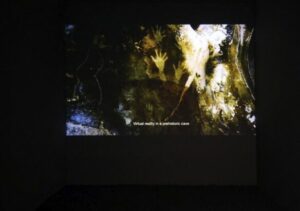
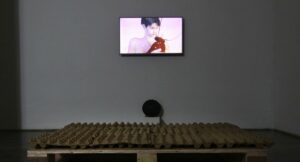
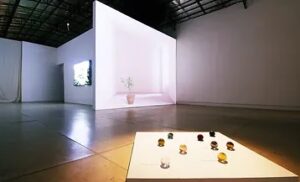
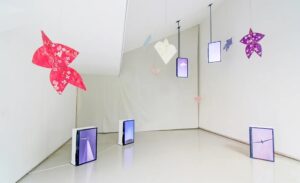
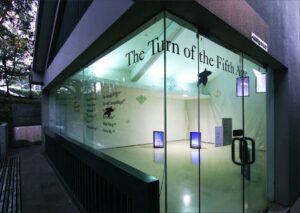
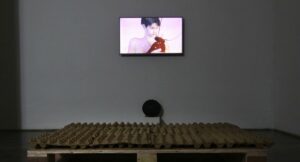
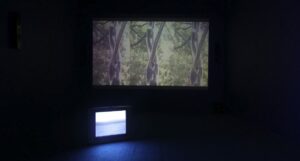
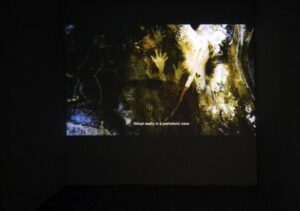
The Turn of The Fifth Age
co-curate with Heru Hikayat and Esther Lu, Artists: Abshar Platisza, Andrita Yuniza, Bakudapan, Tzu-Huan Lin, lololol, Natasha Tontey, Riar Rizaldi, Sorawit Songsataya, Yu-Hsin Su, Tromarama, Yahui Wang, Chi-Yu Wu.
2021.02.26-03.28,Selasar Sunaryo Art Space,Bandung
The Turn
The Turn of the Fifth Age is curated and produced in a world that I would have never imagined, a world of planetary emergencies only seen in disaster films. Esther Lu, in Taipei, was first invited, by email, by Selarsar Sunaryo from Bandung to co-produce a new media exhibition in November 2019. That was before the COVID-19 pandemic. We did not realize then that developing an exhibition premised on Margret Atwood’s Time Capsule Found on the Dead Planet could be so relevant to the situation we are currently facing. In her essay, Atwood describes four different ages that symbolize the gradual progress of civilization. The fifth age is in fact the post-apocalyptic world. This is the reason we named the exhibitionThe Turn of the Fifth Age.
Along with participating artists from Taiwan and Indonesia, we would like to imagine a world that escapes the inevitable destination of Atwood’s text. Is it possible for creative imagination and artistic speculation to impact the direction our world is taking? The original plan was to counter the inevitable acceleration of contemporary exhibition-making with a proposal that was not exhibition focused. Esther and I planned to create a series of discursive workshops, deeply immersing ourselves and the artists in each other’s practices. However, the outbreak of the COVID-19 pandemic made international travel nearly impossible. The exhibition’s response to the current situation, whether in Taipei or Bandung, isre more pressing than ever, not only because art and artists may stimulate and reflect on new ways of seeing and thinking, but also because we would have the chance to challenge prevalent modes of the exhibition-making process from the very beginning.
For me, part of the challenge comes from trying to learn about and understand the artworks of the participating Indonesian artists from a distance that is both physical and epistemological. Throughout the project period, several keywords kept reappearing as I studied the artworks:
Deep Ecology
Deep ecology is an ecological philosophy proposed by Arne Naess in 1973. The idea is to not view nature and non-human species as instrumental tools for human use. This resonates with the worldviews of Tao and ecofeminism – a holistic view of the world. Deep ecology addresses the importance of maintaining biodiversity and self-realization. Self-realization is not understood in the neoliberal spirit of mobilizing one’s own agency the most. Instead, its aim is to achieve commonality among all living species on the planet, transcending the Self, identity, and nation. Deep ecology also puts the ethical responsibility of humans and the sustainability of life on a larger time scale, extending it to the third and fourth generations. On this time scale, the non-human perspective can hold insights on the possibilities of living holistically. In the exhibition, Natasha Tontey’s Pest to Power (2019) urges us to learn from cockroaches, the only species to have survived multiple mass extinction events; while Tromarama’s Domain (2019) sees the ocean through penguin’s eyes. Might self-realization be achieved through the eyes of these species?
Materiality
The omnipresence of media technologies – social media, vlogs, fragmented messages, and so on – dominates the way people consume and produce information. Yet the material infrastructures of these technologies are often neglected in the discussion of media culture. Since The Turn of the Fifth Age is a media art exhibition, it is necessary to discuss the materiality of media. The material infrastructure is entangled with the distinct histories, cultures and natural resources of specific geographical areas, manifesting a certain media culture. Medianature, Jussi Parikka’s term for this, is a variation of Donna Haraway’s natureculture. Previously existing dichotomies, such as nature and culture, biologics and informatics, are in reality interconnected. They cannot be understood separately. As a result, media technologies have to be scrutinized and analyzed by taking their material constitution into consideration. When the focus is shifted to materiality, the grand narrative of contemporary society becomes open to imagination and speculation. Some of the artworks in the exhibition directly address the material reality of Earth. Kasiterit (2019) by Riar Rizaldi uses future AI to look into the extensively exploited tin mine on Bangka island in the Indonesian archipelago. Mooi Indie 21st Century (2019) by Andrita Yuniza reinterprets well-known genres of painting by presenting gleaming spheres made out of chemicals from the textile industry.
Capitalocene
Although the idea of the anthropocene draws much attention in the contemporary art world, Jason Moore’s capitalocene was of more interest to me. Humans are not the only ones creating planetary crisis. The belief in capitalism, clearly expressed in Atwood’s essay as the third age when money became a god, brings the ‘deserts’ that follow. The birth and expansion of capitalism is built on exploiting and consuming the resources of non-white territories, affecting millions of women, colonized people and the non-human. The supremacy of the global techno-economic network escalated the impact of any potential emergency, such as the 2008 financial crisis and the COVID-19 pandemic. Abshar Platisza’s self-powered installation demonstrates the modern anxiety of energy depletion. In order to seek new directions for this planet, we have to question the fundamental beliefs of capitalism; we have to reinvestigate the model of production and reproduction. In terms of production, there is a need to ask how the dynamics and entanglement were formed within and alongside its geo-political history? That legacy, whether toxic or not, still affects every living species and the environment on this planet. The artist collective Bakudapan, for example, appropriated the imagery of Indonesian propaganda to expose the fragility of the food supply chain.
These terms are not the only facet I would like to unfold in the exhibition. However, they are the leads to outline my experience of the reality I am living. Like when I read a piece of fiction with a storyline involving multiple universes, I cannot help wondering: how might this turn out in the end?
Full curatorial essay can be read here